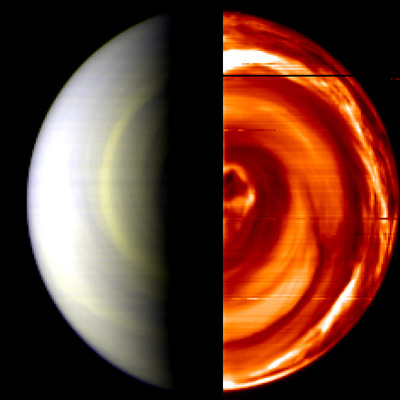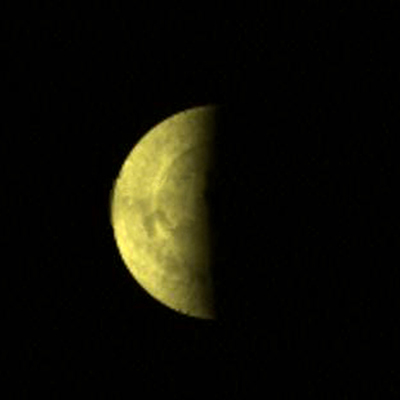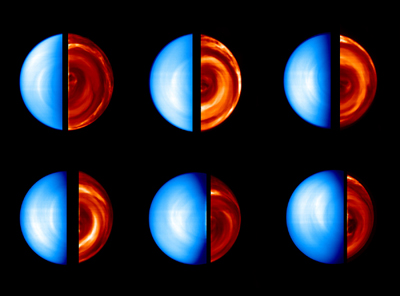13th April 2006: First Venus observations
See the official ESA information about these observations here.
 First Venus observations obtained with VIRTIS in the visible wavelenghts (left)
and the infrared (right).
First Venus observations obtained with VIRTIS in the visible wavelenghts (left)
and the infrared (right).
The left image shows the upper clouds structured around the South Pole
while the right image obtained in the night-side of Venus lets peer into the inner hot levels of
Venus through infrared light.
The infrared image shows clouds opaque regions in black while less cloudy regions bright with more
intensity as radiations comes from lower warmer levels.
These images were captured from a distance of roughly 260.000 km and global images of Venus South polar
region will be regularly obtained at a resolution 4 times bigger in the future. The Southern and Northern mid-latitudes
will be imaged at even a much better resolution with VMC.
Original caption released with the image:
Composite, false-colour view of Venus south pole captured by VIRTIS 12 April 2006 onboard Venus Express.
Credits: ESA/INAF-IASF, Rome, Italy, and Observatoire de Paris, France
 First view of the South Polar Region with the Venus Monitoring Camera
First view of the South Polar Region with the Venus Monitoring Camera
Original caption released with the image:
False-colour view imaged in ultraviolet of Venus south pole captured by the Venus Monitoring Camera 12 April 2006 onboard Venus Express.
Credits: ESA/MPS, Katlenburg-Lindau, Germany

Set of VIRTIS images of Venus Southern hemisphere during the Venus Orbit Insertion.
The summary of the images obtained with the VIRTIS instrument during the Venus Orbit Insertion is presented here.
These observations show the structure of the upper cloud viewed in the visible (blue) and the middle-lower cloud
viewed through Infrared observation windows during the night-side (red).
This global view of the South Polar hemisphere extends from the 12 April 2006 (upper left) to
the 19 April 2006 (bottom right) and will be used to deepen our knowledge of the dynamics of this peculiar atmosphere.
For more details see the original caption released with this image and the high-resolution image.
Credits:ESA/VIRTIS/INAF-IASF/Obs. de Paris-LESIA
 First Venus observations obtained with VIRTIS in the visible wavelenghts (left)
and the infrared (right).
First Venus observations obtained with VIRTIS in the visible wavelenghts (left)
and the infrared (right).
 First view of the South Polar Region with the Venus Monitoring Camera
First view of the South Polar Region with the Venus Monitoring Camera
